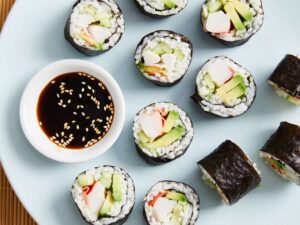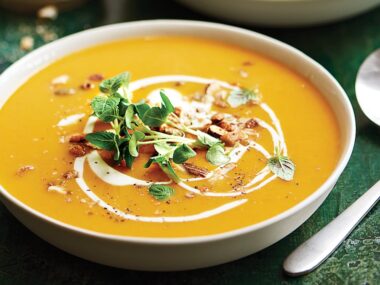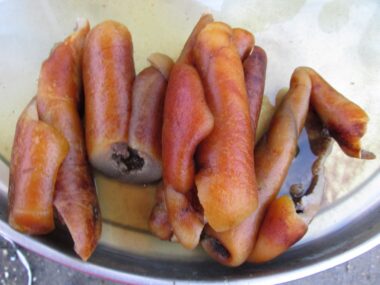Sushi is a beloved Japanese dish that has gained immense popularity worldwide. It is a culinary art form known for its combination of vinegared rice, fresh seafood, and various accompaniments.

Types of Sushi
- Nigiri Sushi: Nigiri sushi consists of hand-pressed mounds of vinegared rice topped with a slice of raw or cooked seafood, typically held together with a small strip of seaweed (nori).
- Sashimi: While not technically sushi, sashimi is thinly sliced raw seafood (often fish) served without rice. It’s usually served with soy sauce, wasabi, and pickled ginger.
- Maki Sushi: Maki sushi is rolled sushi made by wrapping rice, seafood, vegetables, and other ingredients in a sheet of nori and then sliced into bite-sized pieces.
- Temaki Sushi: Temaki sushi, also known as hand rolls, are cone-shaped sushi rolls made by wrapping nori around rice and various fillings, such as fish, vegetables, and sauces.
- Chirashi Sushi: Chirashi sushi is a bowl of sushi rice topped with a variety of sashimi, vegetables, and other toppings. It’s often served decoratively.
Sushi Ingredients
- Sushi Rice: Sushi rice is short-grain white rice seasoned with a mixture of rice vinegar, sugar, and salt. It has a sticky texture that holds the sushi together.
- Seafood: Common seafood choices for sushi include tuna, salmon, yellowtail, shrimp, and eel. Sushi can also feature less common options like sea urchin (uni), squid (ika), and octopus (tako).
- Vegetables: Sushi can contain various vegetables like cucumber, avocado, and pickled daikon radish. Vegetarian sushi options are popular, often including ingredients like tempura sweet potato.
- Condiments: Soy sauce (shoyu), wasabi (spicy Japanese horseradish), and pickled ginger (gari) are commonly served with sushi for added flavor and palate cleansing.
- Seaweed (Nori): Nori sheets are used to wrap sushi rolls and provide a salty, umami flavor and a slight crunch.
Sushi Etiquette
- Soy Sauce: Dip your sushi into the soy sauce fish-side down to avoid soaking the rice, which can cause it to fall apart.
- Wasabi: If the sushi chef hasn’t already added wasabi to your sushi, you can add a small amount to the soy sauce for dipping. Avoid placing a large amount of wasabi directly on the sushi.
- Pickled Ginger: Pickled ginger is eaten between different pieces of sushi to cleanse the palate. It’s not meant to be placed on top of the sushi.
- Chopsticks or Fingers: Sushi can be eaten with chopsticks or fingers, depending on personal preference.
Regional Variations
- Edo-Mae Sushi: Originating in Tokyo, Edo-mae sushi is characterized by simplicity and features mainly nigiri sushi with fresh, local ingredients.
- Kansai Sushi: This style is from the Kansai region of Japan and is known for its use of sweeter vinegared rice and a focus on maki sushi.
- Hako Sushi: Also known as “pressed sushi,” hako sushi is made by pressing rice, fish, and other ingredients into a wooden mold before slicing it into squares.
Sushi Around the World
Apart from this, Sushi has been adapted and embraced in various ways around the world. You can find sushi rolls with creative and non-traditional ingredients like cream cheese, avocado, and spicy mayo in many countries. These adaptations are often tailored to local tastes and preferences.
Also, Sushi is not just a delicious culinary experience but also an art form that celebrates the harmony of flavors, textures, and presentation. Whether you’re enjoying traditional nigiri at a high-end sushi restaurant or grabbing a quick roll at a sushi bar, sushi offers a unique and delightful dining experience.










